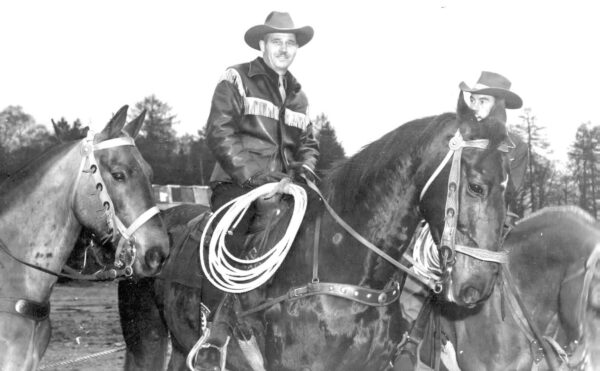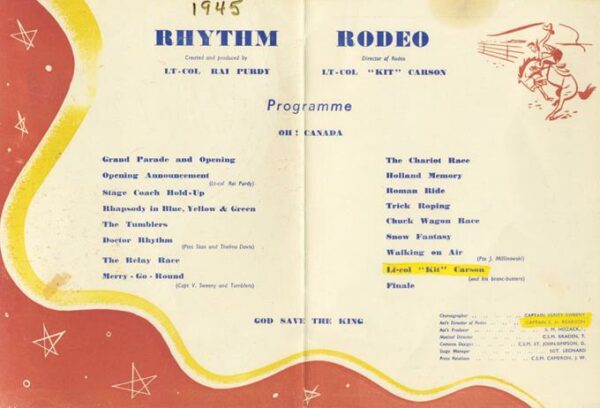
12 Days of Cowboy Christmas
Buck to the Beat
Overseas Rhythm Rodeo Restored Canada’s Image
By Tom Reardon
A rodeo in England to save Canada’s image? Well, sort of.
When WWII ended, the top brass couldn’t just say, “The war is over, everyone go home.” Getting everyone home was a monumental task and it had to be done in an orderly fashion. With half the world’s ships lying on the ocean floor, it meant long waits for passage home.
Many Canadian soldiers were bivouacked at a camp south-west of London at Aldershot. Frustration and tension were mounting, as it seemed to the soldiers that passage would never come. They were getting restless and causing problems in town. The locals were beginning to take a dim view of the Canadians.
It was Lt-Col Rai Purdy who came up with a novel idea for a show that would not only provide a healthy diversion for the troops but also bring a touch of the Canadian West as a thank-you to the long-suffering locals. He was given the permission (and the budget) to pull it off. It was called Rhythm Rodeo.
Purdy had been involved with the Canadian Army Show (CAS), whose agenda was to travel to bases and entertain the troops. The famous comedians Wayne & Shuster got their start with CAS. Many of the CAS personnel had already been discharged and sent home but there was still a core group in England and a few more personnel on the continent.
Purdy proposed to put on the biggest extravaganza in CAS history. It involved a rodeo and stage show under the “Big Top.” In fact, two king-sized circus tents were combined to make the largest tent ever erected in England. The “Big Top” accommodated 2,000 spectators.
Due to British law, they were not allowed to use cattle, so the show was not a true representation of Canadian rodeo. However, there were plenty of horses to fill the bill. There was bronc riding, Roman racing, a mock stagecoach hold-up, a relay race, trick roping, a chuckwagon and a chariot race. Interspersed between the western events were musical numbers or dance routines on the big rotating stage opposite the bucking chutes.
Word of the rodeo spread like wildfire, and several soldiers (men and women) gave up their spot on a ship to remain in England and partake in the show in one way or another.
It was a huge production. The orchestra had 36 musicians and the dance troupe consisted of 40 female and 22 male dancers. There were another 17 soldiers involved in the “Tumblers and Comedy Ballet” and 39 names were listed as “Rodeo Cast, Cowboys, Indians and Drivers.” Twenty-nine people were involved in the technical and stage crew in addition to the four-man purchasing and acquisition crew. Even Canadians back home caught the fever and western tack was shipped in from the Calgary Stampede.
While Purdy was in charge of the overall production, Lt-Col Henry “Kit” Carson and Captain Ed Reardon, both from Maple Creek, Saskatchewan, were in charge of the rodeo.
The horses had to be purchased, conditioned and trained. Chuckwagons, chariots and a stagecoach had to be located and transported to Aldershot. The gearbox out of an army jeep was buried beneath the surface to drive the rotating stage that had to be made from scratch. Grandstands had to be built and with livestock involved there were chores to do.
It was seven months from Purdy’s first proposal until the final show.
Originally, the plan was to use local cold-blooded horses as broncs but with flank straps being against the law, they soon quit bucking. Fortunately, this was realized during the rehearsal phase, so the procurement crew went to Ireland and found some “outlaw” Irish Hunter type horses who bucked and sunfished with the best of them — without a flank strap.


Finally, they were ready. Christmas Day dawned cool and clear and the CAS launched into the first of two shows – one for military personnel – and the most important of all, the second show – staged specifically for the townsfolk who had put up with them so long. Captain Verity Sweeny served as the choreographer and said, “The place was jam-packed full of townsfolk and they had a ball. The kids were so excited.”
One of the more memorable events of Rhythm Rodeo was a wedding that took place when Cupid took aim at Rifleman Lloyd Trottier of Val Marie, Saskatchewan. The bronc rider exchanged vows with Private Christina Weeds who was one of the dancers. The wedding cake was brought to the couple in a chuckwagon pulled by a four-horse hitch. The new Mrs Trottier — while on horseback — cut the cake with a German dress sword captured on the continent. The guests, about 40 mounted “cowboys” and an equal number of “cowgirls,” rode by and received their cake and congratulated the happy couple.
A tremendous number of horses were used in the grand entry as everyone was mounted or driving horses, with the exception of the musicians. It was quite a sight with chuckwagons, chariots and a stagecoach in addition to all the riders and even an “Indian” pulling a travois with his matriarch sitting on it.
Rhythm Rodeo opened on Dec. 21, 1945 and had 22 full house performances. There were over 40,000 troops entertained while awaiting passage home after a job well done but best of all, once again, Aldershot, England loved Canadians.
Tom Reardon is the manager of the Meyronne Community pasture in Saskatchewan. The late Captain Ed Reardon was Tom’s father.
(Originally published in 2004.)
